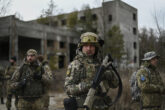October 12, 2021
Don’t Sweat the Small Stuff: Getting Force Design Right in the Next National Defense Strategy
This article was originally published by War on the Rocks.
The narrow window to keep pace with China is closing, and there are signs that the Defense Department is in danger of making a strategic misstep as it develops the next National Defense Strategy. The cornerstone of the forthcoming 2022 strategy is the all-encompassing idea of integrated deterrence. This expansive and ill-defined concept does not promote confidence that the Department of Defense is likely to set clear priorities in its strategy that would enable the force redesign needed to deter and, if necessary, fight and win a war with China or Russia.
The Biden administration should narrowly focus the Defense Department on high-end deterrence against China and Russia instead of strategic competition or managing an expanded array of lesser threats.
The Biden administration should narrowly focus the Defense Department on high-end deterrence against China and Russia instead of strategic competition or managing an expanded array of lesser threats. This strategy would enable the dual nuclear and conventional modernization that is desperately needed to strengthen deterrence, both now and in the future, at current levels of defense spending. Additional resources would not translate to doing more, particularly not when more takes the department’s eye off the ball and encourages a lack of strategic discipline. Rather, any additional resources should translate to doing a narrower range of critical high-end missions more effectively. Urgent change at a significant scale is required to secure the nation today and tomorrow, but this will not occur if the next National Defense Strategy promotes too much of the same.
Read the full article from War on the Rocks.
More from CNAS
-
Defense / Transatlantic Security
When Defense Becomes Destruction: Austria-Hungary’s Mistake and Ukraine’s RiskThis article was originally posted on War on the Rocks. The southeastern Polish city of Przemyśl, with its elegant 19th century Habsburg-era train station, remains one of the ...
By Franz-Stefan Gady
-
Defense / Transatlantic Security
Ukraine’s Catch-22 MomentThis article was originally published in the Financial Times. In Joseph Heller’s wartime classic, Catch-22, the protagonist Yossarian seeks out the US army surgeon Doc Daneeka...
By Franz-Stefan Gady
-
CNAS Insights | Budgetary Own Goals Undermine “Speed and Volume”
On November 7, Secretary of Defense Pete Hegseth laid out a plan to overhaul the Department of Defense’s (DOD’s) acquisition system. Placing an emphasis on delivering new capa...
By Philip Sheers, Carlton Haelig & Stacie Pettyjohn
-
Drones: Who Is Making the New Weapons of War?
From Ukraine and Russia to Gaza and Sudan, drones have become a key weapon of war. Which companies are making them, and profiting from this rapidly expanding but controversial...
By Stacie Pettyjohn




